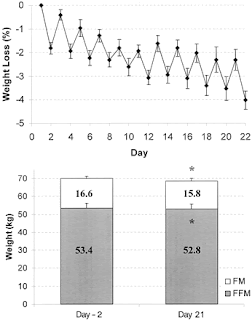What if you can eat whatever you want most days of the week...and still lose weight?
According to
The Fast Diet, a diet book new to the United States,
it's possible. Authors Dr. Michael Mosely and Mimi Spencer say that two fasting days per week can improve your health and physique while eating what you please during the other five days.
Specifically, the book advocates two non-consecutive days per week featuring a maximum intake of 600 calories for men and 500 calories for women. On the other five days, people should eat as they please. This is called a 5:2 approach to fasting. The two calorie-restricted days will lead to an overall calorie deficit for the week and the book claims to improve health as well.
Does this type of intermittent fasting (IF) really produce weight loss or improve health? In this post, I'll discuss different fasting methods, research on fasting, and my own experiences.
Types of Intermittent Fasting
IF features periods of minimal to no calorie consumption with periods of eating as desired. There are many way to perform IF. In addition to the 5:2 method used in The Fast Diet, here are some other ways to fast:
- Alternate Day Fasting (ADF): alternating days of eating whatever you want with days of consuming just one meal, a specific minimal amount of food (i.e. 500 calories), or nothing at all.
- Full-Day Fast (FDF): not eating any calories for one 24-hour period per week.
- 16:8 Fast (16:8): eating during an eight hour period each day while fasting the other 16.
Fasting Studies
Researchers in Baton Rouge, LA used ADF with men and women who were considered at a healthy weight or overweight, according to body mass index, in a 22-day study [
1]. The study subjects ranged from 23-53 years old and were a mix of sedentary, moderately active, and very active individuals. During the fasting days, the participants consumed only calorie-free beverages such as tea, coffee, and water, and were allowed to chew sugar-free gum. On the feasting days, they ate whatever they wanted.
The graphs above demonstrate the results. The line graph shows the percentage of weight loss per day. As you can see, weight fluctuates with each feasting and fasting day, but the overall trend favors weight loss and the study results in a four percent loss. The bar graph shows kilograms of weight in fat mass (FM) and fat-free mass (FFM). The participants lost 1.8 lbs of fat and 1.3 lbs of lean tissue (muscle, bone, etc.).
The results weren't just intriguing for the weight changes. The rate of fat breakdown nearly doubled while resting metabolism did not increase. The quantity of insulin in the blood decreased for men and women. High levels of circulating insulin are negative signs for people who want to lose fat or who are worried about developing diabetes. Blood glucose did not change.
What about ADF with obese individuals?
16 obese men and women in Chicago tried ADF for eight weeks [
2]. The men and women were middle-aged and lightly active. In this study, the fasting day featured about 25-30% of their daily caloric needs. The feasting day allowed participants to eat as they please.
The average weight loss was 1.5 lbs per week. The overall fat loss average was 11.9 lbs and
no lean mass was lost. Systolic blood pressure, total cholesterol, low density lipoproteins, and triglycerides were all lower at the end of the study.
Finally, a shorter study looked at the rate of fat and protein breakdown in 13 men and women [
3]. The participants alternated two-day periods of the 16:8 fasting protocol with a small and frequent meal approach. During the 16:8 days, they ate two meals in eight hours, then fasted for 16. In the comparison two-day period, participants ate seven meals over the course of the day. Both approaches featured basically the same amount of daily calories.
The fasting days demonstrated an accelerated rate of fat breakdown during the last few hours of the fast while protein breakdown was no different between two-day protocols. These results suggest a long term application of a 16:8 IF protocol would not decrease muscle mass but would provide additional fat loss.
My Thoughts and Experiences
In regards to fasting, I spent nine months on a 16:8 protocol in 2009 and
documented my experience on this blog. Like the last study, I ate two meals between noon and 8 PM each day. Over the course of my experience, I lost nine lbs. despite having
a host of social events where people typically gain weight. Two of my clients have tried similar approaches as well, skipping breakfasts while consuming 2-3 meals in an 8-10 hour period per day. Both lost weight while using this approach.
However, there's a major caveat: muscle loss. I lost a noticeable amount of muscle during my trial, and one of my clients gained several pounds of muscle once her fasting period ended. The studies above showed mixed results with fat loss, which could be due to whether people eat at all during fasting days.
As a whole, fasting is effective for weight loss in obese, overweight, and "healthy" weight individuals. Some markers for heart disease and diabetes are improved through fasting, and ADF was even associated with increased lifespan for men and women ages 65 and up [
4].
I do not recommend fasting for people who are pregnant, have eating disorders, or demonstrate unstable blood glucose. On the other hand, fasting can be an effective tool for weight loss and health improvement. Based on the research above, I think fasting with days of absolutely no calorie intake should be avoided to prevent muscle loss. When using other fasting techniques, pay extra attention to your
daily protein intake to prevent or minimize muscle loss.









